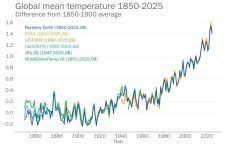Brussels | Reuters — The world could breach a new average temperature record in 2023 or 2024, fuelled by climate change and the anticipated return of the El Nino weather phenomenon, climate scientists say.
Climate models suggest that after three years of the La Nina weather pattern in the Pacific Ocean, which generally lowers global temperatures slightly, the world will experience a return to El Nino, the warmer counterpart, later this year.
During El Nino, winds blowing west along the equator slow down, and warm water is pushed east, creating warmer surface ocean temperatures.
Read Also

World food prices fall for third month in November, UN’s FAO says
World food commodity prices fell for a third consecutive month in November, with all major staple foods except cereals showing a decline, the United Nations’ Food and Agriculture Organization said.
“El Nino is normally associated with record-breaking temperatures at the global level. Whether this will happen in 2023 or 2024 is not yet known, but it is, I think, more likely than not,” said Carlo Buontempo, director of the EU’s Copernicus Climate Change Service.
Climate models suggest a return to El Nino conditions in the late boreal summer, and the possibility of a strong El Nino developing toward the end of the year, Buontempo said.
The world’s hottest year on record so far was 2016, coinciding with a strong El Nino — although climate change has fuelled extreme temperatures even in years without the phenomenon.
The last eight years were the world’s eight hottest on record — reflecting the longer-term warming trend driven by greenhouse gas emissions.
Friederike Otto, senior lecturer at Imperial College London’s Grantham Institute, said El Nino-fuelled temperatures could worsen the climate change impacts countries are already experiencing – including severe heatwaves, drought and wildfires.
“If El Nino does develop, there is a good chance 2023 will be even hotter than 2016 — considering the world has continued to warm as humans continue to burn fossil fuels,” Otto said.
In Canada, El Nino’s effects are seen mostly during winters and springs, when it’s associated with milder-than-normal conditions in western, northwestern and central parts of the country.
Generally, according to Environment Canada, El Nino does not significantly impact Eastern Canada — including the Maritimes — but has been associated with reduced tropical cyclone activity in the Atlantic Ocean.
EU Copernicus scientists published a report on Thursday assessing the climate extremes the world experienced last year, its fifth-warmest year on record.
Europe experienced its hottest summer on record in 2022, while climate change-fuelled extreme rain caused disastrous flooding in Pakistan, and in February, Antarctic sea ice levels hit a record low.
The world’s average global temperature is now 1.2 C higher than in pre-industrial times, Copernicus said.
Despite most of the world’s major emitters pledging to eventually slash their net emissions to zero, global CO2 emissions last year continued to rise.
— Kate Abnett is Reuters’ European climate and energy correspondent in Brussels. Includes files from Glacier FarmMedia Network staff.
















